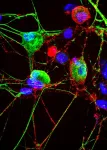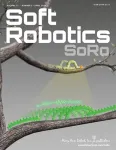(Press-News.org) The typical job of the proteasome, the garbage disposal of the cell, is to grind down proteins into smaller bits and recycle some of those bits and parts. That’s still the case, for the most part, but, Johns Hopkins Medicine researchers, studying nerve cells grown in the lab and mice, say that the proteasome’s role may go well beyond that.
Its additional role, say the researchers, may shift from trash sorter to signal messenger in dorsal root ganglion neurons — cells that convey sensory signals from nerve cells close to the skin to the central nervous system.
Results of their experiments, published April 12 in Cell Reports, show that proteasomes may help those specialized neurons sense the surrounding environment, send signals to each other and potentially differentiate between sensing pain and itch, a finding that could help scientists better understand these sensory processes and new targets for treating pain and other sensory problems.
“Neurons live next to each other for a long time, and they need ways to communicate with each other about what they’re doing and who they are,” says Seth S. Margolis, Ph.D., associate professor of biological chemistry at the Johns Hopkins University School of Medicine. “Proteasomes in the membrane of neurons may help the cells fine tune this messaging process.”
“Proteasomes are more complicated than they appear,” says Margolis. He and his colleagues first found proteasomes in the plasma membranes of central nervous system neurons in mice in 2017, which they dubbed neuronal membrane proteasomes, and have continued studying how these special proteasomes promote messaging, or crosstalk, among neurons.
At the time, Margolis’ focus was on the central nervous system, encompassing the brain and spinal cord. But later, he collaborated with neurobiologist Eric Villalón Landeros, Ph.D., postdoctoral fellow in Margolis’ laboratory at Johns Hopkins, whose work focuses on the peripheral nervous system, the network of neurons running through the rest of the body, closer to the skin, capturing sensory information from the environment.
Margolis and Villalón Landeros wondered whether proteasomes could be found in peripheral neurons, and if so, what they might do.
Using mouse antibodies that glom on to proteasomes, and other methods, the investigators found the proteasomes on the surface of neurons in the spinal cord, dorsal root ganglia, sciatic nerve and peripheral nerves innervating skin.
The researchers were also able to find proteasomes in the same type of peripheral neurons grown in laboratory culture dishes.
To understand the proteasome’s function in peripheral sensory neurons, the researchers gave mice biotin-epoxomicin, a cell membrane-impermeable proteasome inhibitor that blocks the function of neuronal membrane proteasomes. Then, they performed classic sensory tests.
The researchers found that the mice that got injections of the proteasome-blocking drug biotin-epoxomicin on one side of the body were between 25% to 50% slower than the other side to respond to sensory tests.
“This suggests that membrane proteasomes are important for sensation, and they must be facilitating this at the signaling level,” says Margolis.
The researchers used single cell sequencing technology to determine that membrane proteasomes were expressed in a subpopulation of neurons involved in itch sensation and known to be sensitive to histamine, an immune system compound that launches an animal’s (including human’s) response to allergens.
In laboratory culture dishes, the researchers stimulated both itch-related and non-itch related neurons and blocked their membrane proteasomes with biotin-epoxomicin. This resulted in changes to activity in all of the cells. “Blocking proteasomes seems to have an activity-modulatory effect across all the cells, despite being expressed in a subpopulation, suggesting that proteasomes facilitate a kind of cross talk between these cells,” says Margolis.
Proteasome blockers, including one called Velcade, are currently used to treat certain types of cancer.
Villalón Landeros and Margolis plan to continue working together to determine how neuronal membrane proteasomes function in sensory neurons and in sensing pain versus itch. “We want to see if we can manipulate neuronal membrane proteasomes to have a different outcome on pain and itch sensation,” says Villalón Landeros.
Additional scientists who contributed to the research are Samuel Kho, Taylor Church, Anna Brennan, Fulya Türker, Michael Delannoy and Michael Caterina from Johns Hopkins.
Funding for the research was provided by the National Institutes of Health (F32NS119202, R01 NS110754) and a Merkin Peripheral Neuropathy and Nerve Regeneration Center grant.
END
Cell’s ‘garbage disposal’ may have another role: helping neurons near skin sense the environment
2024-04-12
ELSE PRESS RELEASES FROM THIS DATE:
Study reveals potential to reverse lung fibrosis using the body’s own healing technique
2024-04-12
he most common type of lung fibrosis — scarring of the lungs -- is idiopathic, meaning of unknown cause.
Researchers are urgently trying to find ways to prevent or slow idiopathic pulmonary fibrosis (IPF) and related lung conditions, which can cause worsening shortness of breath, dry cough, and extreme fatigue. Average survival following diagnosis of IPF is just three to five years, and the disease has no cure.
A recent U-M study from a team led by Sean Fortier, M.D. and Marc Peters-Golden, M.D. of the Division ...
International team co-led by a BSC researcher discovers more than 50 new deep-sea species in one of the most unexplored areas of the planet
2024-04-12
An international group of scientists, co-led by researcher Ariadna Mechó of the Barcelona Supercomputing Center - Centro Nacional de Supercomputación (BSC-CNS), observed 160 species on seamounts off the coast of Chile that had not yet been known to live in the region and suspect that at least 50 of these species are new to science. The recent Schmidt Ocean Institute expedition to the underwater mountains of the Salas y Gómez Ridge, a remote and underexplored area that stretches from ...
Cleveland Innovation District partners exceeding many targets set by state and JobsOhio
2024-04-12
CLEVELAND – Since the Cleveland Innovation District launched in 2021, the founding institutions have made significant progress, including exceeding many of the targets set by the Ohio Department of Development and JobsOhio. Collectively, the institutions participating in this $500 million public-private initiative have created more than 2,600 jobs, spent nearly $1.2 billion on research and innovation, commenced construction of two new research facilities, created dedicated research space comprising more than 550,000 square feet, and awarded more than 7,300 degrees and certificates to support workforce development.
“The Cleveland Innovation District’s progress ...
A third of women experience migraines associated with menstruation, most commonly when premenopausal
2024-04-12
WASHINGTON (April 12, 2024) – A third of the nearly 20 million women who participated in a national health survey report migraines during menstruation, and of them, 11.8 million, or 52.5%, were premenopausal. The analysis was conducted by researchers at Georgetown University Medical Center and Pfizer, Inc., which makes a migraine medication.
Because of the underuse of medications to help treat or prevent menstrual migraines, investigators wanted to understand how common menstrual migraines were and which groups of women could most benefit from potential therapies. The study will be presented April 16, at the American Academy of Neurology ...
MD Anderson Research Highlights for April 12, 2024
2024-04-12
HOUSTON ― The University of Texas MD Anderson Cancer Center’s Research Highlights showcases the latest breakthroughs in cancer care, research and prevention. These advances are made possible through seamless collaboration between MD Anderson’s world-leading clinicians and scientists, bringing discoveries from the lab to the clinic and back.
Recent developments at MD Anderson offer insights into a combination strategy to improve immunotherapy responses, promising trial results for patients with tumors harboring BRAF mutations, a maintenance strategy for patients with acute myeloid leukemia following chemotherapy, a strategy ...
Soft Robotics appoints new Deputy Editor-in-Chief, Barbara Mazzolai, PhD
2024-04-12
Mary Ann Liebert, Inc., is pleased that Barbara Mazzolai, PhD, has been appointed the new Deputy Editor-in-Chief of the bimonthly journal Soft Robotics. Dr. Mazzolai joins Barry Trimmer, PhD, as part of the executive editorial team for the journal.
Soft Robotics is the leading robotics journal devoted to the emerging technologies and developments of soft and deformable robots. The journal’s coverage includes flexible electronics, materials science, computer science, and biomechanics. The journal breaks new ground as the first to answer the urgent need for research on robotic technology that can safely ...
Wiley releases Mass Spectra of Designer Drugs 2024 to accelerate forensics analysis of fentanyls, cannabinoids, and more
2024-04-12
Wiley, one of the world’s largest publishers and a global leader in research and learning, today announced the 2024 release of the Mass Spectra of Designer Drugs.
This indispensable spectral database serves as a cornerstone for forensic laboratories worldwide, enabling swift identification of illicit substances. Sourced from both legal and underground literature, it provides access to the latest novel psychoactive substances (NPS) like variants of fentanyl, xylazine, various opioids, synthetic cannabinoids, and more.
This annually refreshed database provides access to 35,094 mass spectra representing 26,712 unique ...
Freestanding emergency departments are popular, but do they function as intended?
2024-04-12
By Ann Kellett, Texas A&M University School of Public Health
Freestanding emergency departments (EDs) — either satellite branches of hospitals or independently operated facilities — have popped up across the country. Texas has the most, with 338 freestanding EDs as of May 2023, and these facilities handle nearly one quarter of all emergency department visits in the state.
Now, a new study from the Texas A&M University School of Public Health is the first to compare the characteristics of visits to freestanding EDs with visits to traditional hospital-based ...
University of Cincinnati experts present at national neurology conference
2024-04-12
University of Cincinnati researchers will present abstracts at the American Academy of Neurology annual meeting 2024, April 13-18 in Denver, Colorado.
Two-component treatment leads to improvement for patients
Late-onset Pompe disease (LOPD) is a rare, inherited genetic disease caused by the accumulation of glycogen, the body’s stored form of glucose, in muscles and other organs. Left untreated, the muscle weakness it causes can lead to the loss of the ability to walk and breathing impairment.
A research team led by UC’s ...
Bonobos are more aggressive than previously thought
2024-04-12
Chimpanzees and bonobos are often thought to reflect two different sides of human nature—the conflict-ready chimpanzee versus the peaceful bonobo—but a new study publishing April 12 in the journal Current Biology shows that, within their own communities, male bonobos are more frequently aggressive than male chimpanzees. For both species, more aggressive males had more mating opportunities.
“Chimpanzees and bonobos use aggression in different ways for specific reasons,” says anthropologist and lead author Maud Mouginot of Boston University. “The idea is not to invalidate the ...







